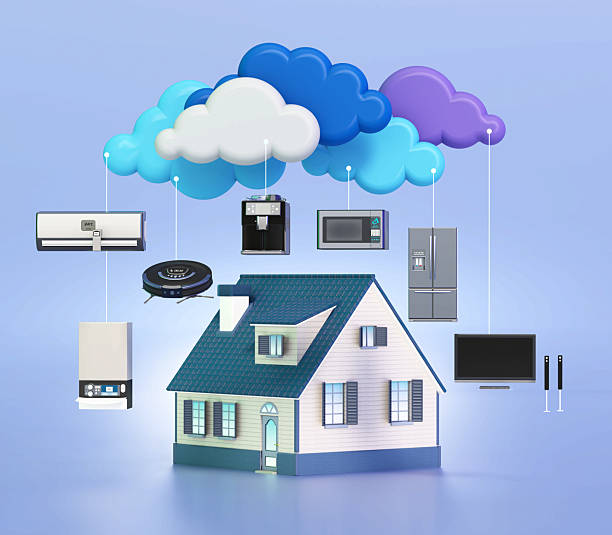Over the past several years, we’ve been transitioning to a new age of technology. In a traditional house, you must turn your lights on or off, open or close your windows or physically use a metal key to unlock your front doors. In a smart house, you can press only one button and have control over your entire house.
Smart home technology has evolved significantly, and it’s impacting modern living. It’s noted that initially, the meaning for “SMART” stood for Self–Monitoring, Analysis, and Reporting Technology; however, it’s evolved to represent a broader concept of intelligent and interconnected devices in the digital world. Smart devices are often connected to networks such as the internet or Bluetooth, allowing communication with each other to share data.

A modern house displays various smart appliances linked to cloud services above. Devices include a refrigerator, microwave, and a robotic vacuum, illustrating advanced home connectivity.
So basically, the residence is equipped with internet-connected devices allowing for remote control and automation of a variety of household functions, enhancing convenience. Some examples include smart thermostats, coffee machines, lighting systems and security systems, which can all be controlled remotely. Refrigerators that track food inventory and washing machines that optimize energy consumption. So, say if you leave your residence and you’ve forgotten to turn your oven or other appliances off, you can do so with the smart features.
Other advantages with smart technology, smart speakers integrate with other smart devices and provide voice control for various functions, smart security systems offer assurance and peace of mind of enhanced protection for your home, the devices can optimize energy consumption leading to saving you money and smart home features can make your home more attractive for a potential buy once putting your house on the market.
Although having a smart house is a modern technology convenience, there are some disadvantages.
It’s been noted that smart homes can be complex, and there is no standard protocol that allows all devices to communicate with each other. Although supported by every major provider in the smart home space, it’s still a work in progress and not universally adopted. A system must be able to gather information on a person, such as location, their daily habits, and voice data, to be able to work specifically for the individual. Because of the massive amount of data collected by smart home systems, it’s susceptible to security breaches. Hackers can infiltrate a smart home’s camera system to spy on them or take control of lights and the alarm system, leaving access to a home break-in. All sensitive information that smart devices collect, including strong passwords and encryption hooked up to the internet, is vulnerable to being hacked.
Thankfully, manufacturers are implementing stronger encryption and regular security updates to protect devices. Smart device users are encouraged to change default passwords and review permissions to reduce risks. Users can also choose to minimize the data shared with smart devices, like deleting recordings.
Investing in a smart home can be worthwhile for many homeowners, with many benefits to offer. Carefully evaluate your needs, priorities and budget before making your decision and ensure that the devices you choose are compatible with your existing system.







Add Comment
You must be logged in to post a comment.